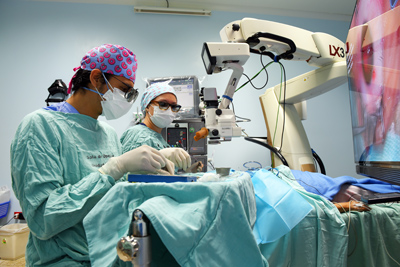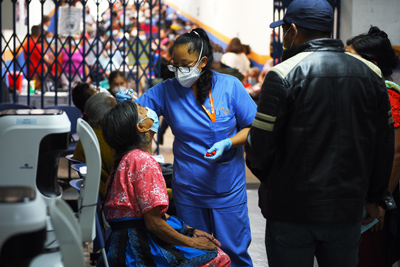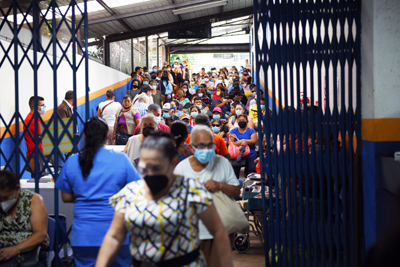By C. Todd Lopez
GUATEMALA CITY, Guatemala (Oct. 31, 2022) -- Last month, airmen and soldiers from Joint Task Force-Bravo, Soto Cano Air Base, Honduras, concluded a more-than-month-long operation in Guatemala and Honduras meant to improve not just eyesight, but also the relationships and partnerships between U.S. military medical doctors and Latin American doctors.
The HEART 22 operation -- which stands for Health Engagements Assistance Response Team -- began in July in Honduras and ran all the way up to early September, finishing in Guatemala. During the operation, dental, orthopedic and ophthalmologic professionals from around the U.S. military partnered with local medical professionals in both nations to provide care for citizens there, and build enduring partnerships .

In Guatemala City, for instance, a handful of uniformed ophthalmologists from around the U.S. military worked together with skilled ophthalmologists and ophthalmology residents from around Latin America to perform critical eye surgeries, including corneal transplants and cataract surgery at the Guatemala National Ophthalmology Unit, also called UNO.
At the clinic, U.S. military medical professionals weren't just reducing backlogs of patients or treating patients that might not otherwise get treated. Instead, they were developing and strengthening peer-to-peer relationships between U.S. military and Latin American ophthalmologists, while sharing professional knowledge, said Air Force Lt. Col. (Dr.) Richard Townley, an ophthalmologist who participated in HEART 22 and is stationed in Alaska.
"This was about skills transfer and partnerships," Townley said. "We're hoping to establish relationships here, since this is the central Mecca of ophthalmology training for Central America."
The UNO clinic in Guatemala City is well-known by ophthalmologists throughout Latin America and has become a choice location to complete their residency training. This means that U.S. military ophthalmologists participating in HEART 22 had plenty of opportunity to meet some of the residents and form relationships that might be useful later during other operations in Latin America.
"When we want to go to any remote region, we may be able to entice them to partner with us or they will have contacts in those locations to partner with," Townley said.

Having those partnerships is important, Townley said, because when the U.S. military wants to go into a country on a medical mission, advance coordination with local medical providers ensures the most successful mission possible.
"As Americans, we sometimes see an area of need, and we want to immediately fix it without taking everything into consideration," Townley said. "On the civilian side, they would sometimes go into an area and see there's a lot of blind people [and want to] do a mission there. But if you do it without actually getting to know what resources are there already, if there's any specialists there already, you can actually do more harm than good."
Even when good work is being done, Townley said if medical treatments such as eye surgery are done without working closely with resources already available in a region, it's possible to undermine the fragile economies in place that might support doctors already there. It's also important that if U.S. medical doctors go into an area to do work, they ensure those patients will have access to any follow-up care once the U.S. doctors depart. Without making sure that follow-up care is available, then doctors might be doing more harm to those patients than good.
Also, a benefit of HEART 22 is that when U.S military ophthalmologists work with Latin American counterparts, everybody learns something, Townley said. For U.S. military ophthalmologists, that meant learning how to work with less than what's expected back in the U.S. while still being successful. That's a skill that's important anytime the military goes into combat.
"It exposes us to situations where we may have to work with less," he said. "It's important to know if there [are] other ways of doing things and how do people with [fewer] resources work in a resource-constrained environment."

In a peer-to-peer conflict, Townley said, the U.S. might not have the air superiority necessary for providing medical personnel with the supplies they expect.
"What I see in this environment, is that it helps us learn other techniques, and how to utilize our resources more fastidiously so that we can potentially reuse stuff, know what we can get away with and what we can't, and safely," he said. "I've learned new techniques that I wasn't aware of, that we don't need in the U.S., because we don't necessarily have as advanced diseases. But I've learned ways of sterilization that are more efficient."
In Latin America, Townley said, ophthalmologists are more likely to perform manual small incision cataract surgery, or MSICS. The MSICS procedure is faster and less resource-intensive than the more traditional cataract surgery ophthalmologists in the U.S. are used to. The technique is popular in developing nations because it doesn't require as much equipment or supplies. In Guatemala and Honduras, he said, American ophthalmologists were able to become more familiar with the technique, which he said is a good thing.
"In the military, we want to make sure as many ophthalmologists are exposed to this as possible," he said. "By doing more of these missions we can keep our ophthalmologists more current and ready for deployment."
The U.S. medical providers brought a knowledge exchange to their counterparts as well, Townley said. For example, neuro-ophthalmology is not something they had in Guatemala, and Townley said it was something he knew could be useful.

"We actually brought a neuro-ophthalmologist with us on our team to teach them one-on-one," he said.
The UNO clinic director, María L. Ruíz-Rodríguez, said in the past she knows that U.S. military doctors have come to offer only medical services, as a kind of humanitarian mission. And while she said she, the doctors at her clinic, and other clinic stakeholders appreciate the effort, it's not how they like to do business.
During this first iteration of HEART, she said, things were different. She said early in the planning there was a focus on partnering and education rather than on just performing work. That was a welcome change, she said.
At the clinic, she said, there are residents from all over Latin America, including Peru, Ecuador, Colombia, Mexico, Honduras and El Salvador.
"The students come here and study ... we have had people from everywhere," she said. "It's better to come and teach these kids new techniques, because they're going to go back to their countries and they're going to replicate it there. So, you're just not [benefitting] the patients. During a surgery, you are [benefiting] the doctor, the technologist and other people they're going to work with in the future."

Another thing the U.S. military brought to Guatemala through HEART 22 was the promise of a new electronic patient records system for the UNO clinic, which Ruíz-Rodríguez said will change things dramatically.
The records room at the clinic is stacked high with thousands of paper records. And around the clinic, wherever patients are, their paper records must go with them so doctors can refer to them and update them.
Implementation of electronic records will save a lot of time for doctors, Ruíz-Rodríguez said, which means they can spend less time filling out paperwork and spend more time seeing patients. She said she expects the clinic will be online with the new system by January.
Air Force Staff Sgt. Brian C. Russell, an ophthalmic technician stationed at Lackland Air Force Base, Texas, was one of the handful of enlisted medical personnel who participated in HEART 22. He's been in the Air Force for nine years now and has deployed in his career field to Afghanistan. He's also completed a humanitarian mission to Panama.
In Guatemala and Honduras, he said, his role is to assist medical providers with their work, set up equipment and order supplies.

While both American military and Latin American ophthalmologists learned from each other during HEART 22, Russell said he learned as well, including about operating in an environment that's not as well-resourced, and also with new techniques.
"There's been a whole slew of knowledge exchange between not only our docs, but also the doctors here teaching our doctors different methods of surgery that we don't normally do back home," he said. "Back at Lackland we don't see as many trauma-related eye injuries. I've had experience with those before, but here we're just seeing more. It's more common here. That helps me as a technician learn how to assist in different procedures that we don't normally see."
In terms of supplies, he said, not everything they'd have at home made it down to Guatemala or Honduras -- and that's a learning experience as well, he said.
"There is a lot of utilizing the resources that we have and kind of making do with what we have," he said.
The HEART 22 mission kicked off in Tegucigalpa, Honduras in mid-July and completed the mission in early September in Guatemala. About 50 U.S. military medical professionals and support personnel form both the Air Force and the Army participated in the operation.